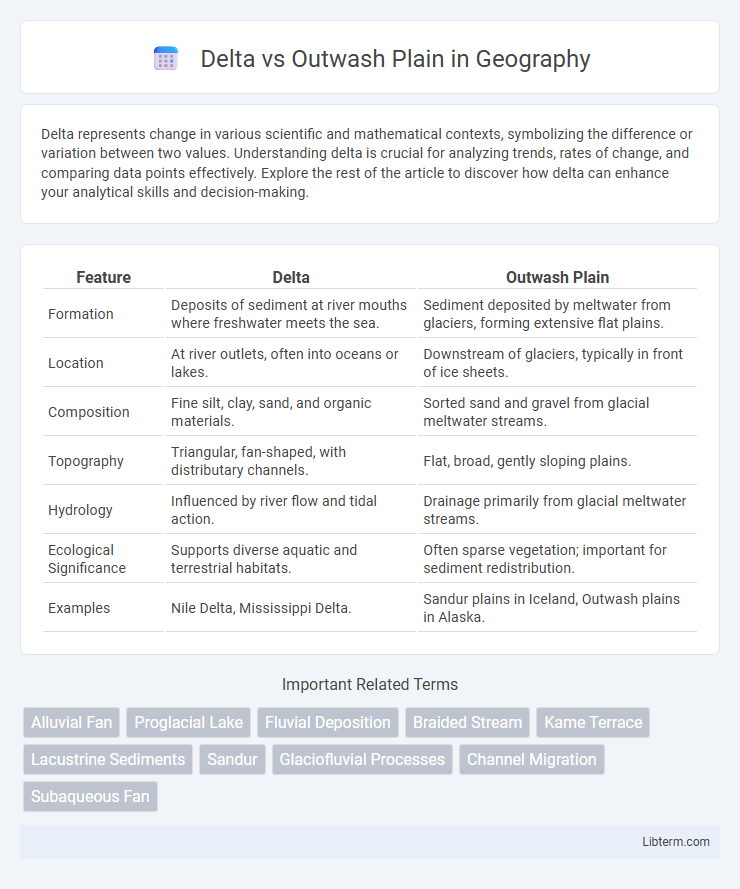Delta represents change in various scientific and mathematical contexts, symbolizing the difference or variation between two values. Understanding delta is crucial for analyzing trends, rates of change, and comparing data points effectively. Explore the rest of the article to discover how delta can enhance your analytical skills and decision-making.
Table of Comparison
| Feature | Delta | Outwash Plain |
|---|---|---|
| Formation | Deposits of sediment at river mouths where freshwater meets the sea. | Sediment deposited by meltwater from glaciers, forming extensive flat plains. |
| Location | At river outlets, often into oceans or lakes. | Downstream of glaciers, typically in front of ice sheets. |
| Composition | Fine silt, clay, sand, and organic materials. | Sorted sand and gravel from glacial meltwater streams. |
| Topography | Triangular, fan-shaped, with distributary channels. | Flat, broad, gently sloping plains. |
| Hydrology | Influenced by river flow and tidal action. | Drainage primarily from glacial meltwater streams. |
| Ecological Significance | Supports diverse aquatic and terrestrial habitats. | Often sparse vegetation; important for sediment redistribution. |
| Examples | Nile Delta, Mississippi Delta. | Sandur plains in Iceland, Outwash plains in Alaska. |
Introduction to Delta and Outwash Plains
Deltas form at river mouths where sediment deposition occurs as the river velocity decreases entering a standing body of water, creating rich, fertile land often characterized by distributary channels. Outwash plains develop in front of glaciers from meltwater streams depositing stratified sediments, creating broad, flat landscapes with well-sorted sands and gravels. Both landforms represent sedimentary processes but differ in origin, sediment sorting, and environmental setting.
Formation Processes: Delta vs Outwash Plain
Deltas form at the mouth of rivers where sediment-laden water slows upon entering a standing body of water like an ocean or lake, causing sediments to deposit and create distinct, fan-shaped landforms with distributary channels. Outwash plains develop from glacial meltwater streams that carry and deposit sediments beyond the glacier terminus, sorting materials by size and forming extensive, flat or gently sloping plains composed primarily of sand and gravel. The key difference lies in the depositional environment: deltas accumulate in aquatic settings influenced by wave, tidal, and river dynamics, while outwash plains are shaped by terrestrial meltwater flow from retreating glaciers.
Key Geographical Locations
The Mississippi River Delta in the United States exemplifies a delta region where sediment deposits create new landforms at the river mouth. Contrastingly, the Outwash Plain in southern Iceland is a glacially formed landscape dominated by sediment spread over a broad area by meltwater streams. Both formations highlight distinct sedimentary processes shaping coastal and glacial environments globally.
Sediment Composition and Distribution
Delta sediment composition consists mainly of fine silt, clay, and organic matter deposited as river flow velocity decreases upon entering a standing body of water. Outwash plains feature coarser sediments such as sand, gravel, and larger rock fragments transported and deposited by glacial meltwater streams. Sediment distribution in deltas is typically layered, with finer particles settling further from the river mouth, while outwash plains exhibit well-sorted, stratified sediments distributed across broad, gently sloping surfaces.
Hydrological Dynamics
Deltas form where riverine sediment deposition occurs at the mouth of a river, creating a network of distributary channels that slow water flow and promote sediment settling. Outwash plains develop from glacial meltwater streams depositing sorted sediments over broad, flat areas, characterized by braided channels and high stream velocities. Hydrological dynamics in deltas emphasize sediment retention and channel bifurcation, while outwash plains demonstrate rapid water flow and extensive sediment redistribution during melt seasons.
Ecological Significance
Deltas create nutrient-rich environments supporting diverse aquatic and terrestrial species by depositing fine sediments at river mouths, fostering fertile wetlands and estuaries. Outwash plains, formed by glacial meltwater deposits, offer well-drained soils that sustain unique plant communities adapted to coarse sediments and variable moisture. Both landforms contribute critical habitats that enhance regional biodiversity and support ecological resilience.
Human Impact and Land Use
Deltas often face significant human impact due to their fertile soils and access to waterways, making them prime locations for agriculture, urban development, and industrial activities, which can lead to land subsidence, pollution, and habitat loss. Outwash plains, formed by glacial meltwater deposits, are typically less fertile and less densely populated, but they are often used for grazing, logging, and sometimes mining, with landscape alterations affecting natural drainage and soil stability. Both landforms require careful land use management to balance economic benefits with environmental sustainability and mitigate issues such as erosion and contamination.
Morphological Differences
A delta forms at a river's mouth where sediment accumulates as flowing water slows upon entering a standing body of water, creating a typically triangular, lobate, or bird-foot morphology. An outwash plain, by contrast, develops from glacial meltwater depositing well-sorted sediments over a broad, flat area, characterized by stratified sands and gravels with braided stream channels. The delta's morphology is shaped predominantly by fluvial-lacustrine interactions, whereas outwash plains reflect glaciofluvial depositional processes with extensive lateral sediment dispersal.
Case Studies and Examples
The Mississippi River delta exemplifies a classic delta formation, showcasing sediment deposition that creates landforms ideal for agriculture and wildlife habitats. The Outwash Plain in Iceland, shaped by glacial meltwater during the last Ice Age, serves as a prime example of sediment spread over vast flat areas, forming fertile soils but lacking deltaic distributary channels. Studies of the Ganges-Brahmaputra delta versus the Outwash Plains in Alaska reveal contrasting sedimentation patterns influenced by fluvial versus glacial processes, highlighting their distinct geomorphological characteristics and ecological impacts.
Conclusion: Delta or Outwash Plain?
Deltas form at river mouths where sediment deposits create fertile, often triangular landforms shaped by water flow and wave action. Outwash plains develop from glacial meltwater carrying sorted sediments, yielding broad, flat expanses of sand and gravel. Choosing between a delta or outwash plain depends on the sediment source and depositional environment, with deltas linked to river and ocean interactions and outwash plains associated with glacial meltwater processes.
Delta Infographic

 libterm.com
libterm.com